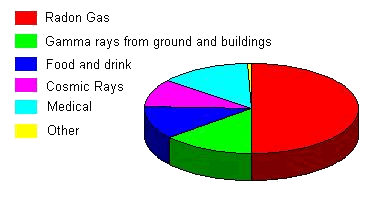Nuclear
Power - Safety

Everyone is exposed
to background radiation from the sun and outer space and from the natural radioactivity in rocks,
soil, buildings and diet. These sources account for 85% of the average
person's annual radiation dose andmost ofthe rest comes from medical sources
such as X-rays.
 The contribution from
nuclear industry discharges is said to amount to less than 0.1% of the total. Over
a year this amounts to less than the radiation dose received from eating
one brazilnut. (These nuts naturally accumulate radioactive elements from
the soil during growth.)
The contribution from
nuclear industry discharges is said to amount to less than 0.1% of the total. Over
a year this amounts to less than the radiation dose received from eating
one brazilnut. (These nuts naturally accumulate radioactive elements from
the soil during growth.)
Nuclear power stations can release radioactive paricles into the environment in a more concentrated form than they would be naturally found. Radioactive isotopes are dangerous to living organisms as radioactive particles emit ionising radiation and these can cause cell mutations that can cause cancer. This release of radioactivity can happen due to operational discharge from the plant or by disposal of waste.
Nuclear waste is a mixture of short and long half radioactive isotopes. It must therefore be carefully dealt with. Radioactivity
decreases exponentially with time and initially the rate of decay is very rapid, but the waste is split into three main categories - high, intermediate and low so that it is dealt with as efficiently as possible. See this page for more detail.
Discharges of radioactive material into the environment
Very low levels of
radioactivity should be released from nuclear plant in gaseous emissions via
stacks or in liquid effluent discharged to the sea. These releases are
instructed to be kept below authorised limits set by the Environment Agencies, using a
variety of techniques such as filtration and ion-exchange treatments.
These limits ensure that the levels of radioactivity released to the environment
are negligible compared with natural background levels. The discharges
are monitored by both the nuclear industry and the Ministry of Agriculture,
Fisheries and Food and the results of the monitoring are published regularly.
As a result of these controls, population radiation exposure due to discharges
from a nuclear power station is about the same as that due to the emissions
from a coal-fired station, arising from the traces of natural radioactivity
in the coal.
Safety in the UK
In its 1995 Policy Review the UK Government concluded that underground disposal was the favoured option for the long-term management of vitrified high
level waste and reported that it was putting in hand development of a
research strategy, with the aim of producing a statement of future intent
in this area. It also concluded that a repository for the disposal of low and intermediate level radioactive waste should be constructed as
soon as reasonably practicable. In the meantime disposal of low level waste
by shallow burial at the Drigg site in Cumbria would continue.
Childhood Leukaemia and proximity to nuclear power plants
Nuclear Accidents



 The contribution from
nuclear industry discharges is said to amount to less than 0.1% of the total. Over
a year this amounts to less than the radiation dose received from eating
one brazilnut. (These nuts naturally accumulate radioactive elements from
the soil during growth.)
The contribution from
nuclear industry discharges is said to amount to less than 0.1% of the total. Over
a year this amounts to less than the radiation dose received from eating
one brazilnut. (These nuts naturally accumulate radioactive elements from
the soil during growth.) 


